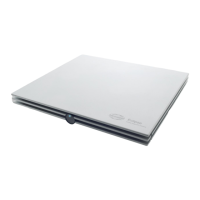Eclipse Additional Information Page 204
10.2 FAQ – ABR
10.2.1 ABR preparation
Q: Must all four/three electrodes be mounted?
A: Yes. If you do not place the contra lateral electrode rejection will occur, as both ipsilateral and contra-
lateral EEG is evaluated in determining rejection.
All sockets on the preamplifier must be attached to that patient, thus all 3 electrodes must be mounted
when using the EPA3 and all 4 electrodes must be mounted when using EPA4.
Q: Can I use any type of electrode?
A: In principle yes. However, certain facts should be considered:
Transtympanic electrodes: Often high impedance must be expected, exceeding the impedance scale
of the Preamplifier. This means that you cannot, from the impedance reading, tell whether the elec-
trode has an acceptable contact or not. That, however, can be determined from the raw EEG curve,
which will indicate very high EEG values, when poor contact is made.
The Preamplifiers ability or lack of ability to read the impedance has in itself, no consequence for the
recording as the impedance measuring circuitry is disconnected from the rest of the Preamplifier cir-
cuitry during recording.
Mixing electrodes is in general not recommended as different dc potentials may evolve due to differ-
ences between the metals involved. However, Tip Trodes generally work reasonably well in connec-
tion with traditional electrodes for ground and vertex.
Mixing electrode types may also result in differences in impedance between the electrodes involved.
This will cause a reduction in Common Mode Rejection, allowing more noise to enter the recording.
Q: Is mastoid placement for electrodes always recommended?
A: Mastoid placement is easy to perform and good impedances are usually not difficult to obtain. Earlobe
placement is often found to be less practical but has the advantage of providing a stronger wave I and
is less prone to disturbance from the post auricular muscle PAM artefact, which sometimes shows up
as a large peak at approximately 10ms when loud stimuli are used.
Q: I have problems getting one of the electrodes’ impedance down.
A: Disconnect all electrodes, and reconnect the lead wires to different electrodes. If the problem seems to
have moved to another electrode the electrode lead may be faulty.
Because of the way in which impedances are measured if the ground electrode lead is faulty , then
the impedance for the Right electrode will indicate a relatively high impedance. The same interrelation-
ship is found between the Left electrode and the Vertex electrode)
The LBK15 box (optional accessory) may be helpful in determining such problems.
10.2.2 ABR Recordings
Q: Unclear or small wave V on patients that should perform well. What can be wrong, and what
can I do about it?
A: Stimulation intensity must be well above the patient’s threshold for a large wave V to appear. Please
note, that if your instrument is calibrated to peSPL, you should realise that a 70dBpeSPL click stimu-
lus equals only about 35dBnHL. Stimuli in dBnHL are comparable to normal dBHL. You will find the
peSPL or nHL indication in the lower part of the Recording screen and Edit screen as well as on the
printout.
Insert phones must be correctly inserted, to deliver the appropriate stimulus level to the ear. Please
follow instructions supplied with the insert phones.
Display gain can be set by the arrows at the top of the y-axis. This will have a big impact on the way
the waves appear. Individual display gain can be selected for any individual curve by selecting the
right hand mouse button while pointing at the curve handle.

